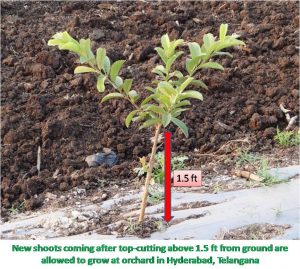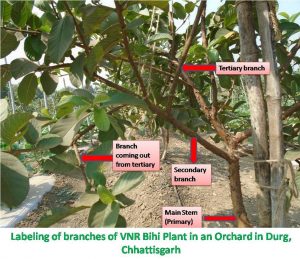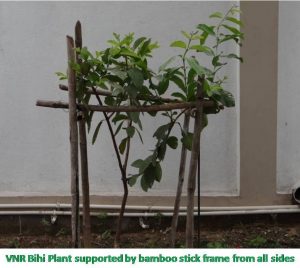What is training?
Training is cutting/supporting of branches in initial stage (before fruiting) to give desired stature to the VNR Bihi plant.
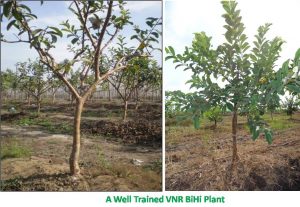
Why training is required in VNR Bihi plant?
Training of VNR Bihi plant is done to:
- Allow sunlight to pass through every branch and centre of the plant. This ensures minimum chances of development of insects and other pests. Insects and pests proliferate in dark.
- Get maximum yield from the plant in confined space.
- Make all branches accessible so that operations like harvesting, bagging can be done easily.
Materials required for training of VNR Bihi plant:
- Secateur (cutter)
- Jute thread/ sutli
- Measuring tape

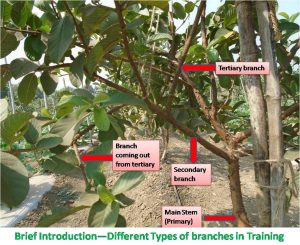
How to do training of VNR Bihi plant?
1. Top-cutting: Plants when grow up to the height of 2 ft from ground, their top is cut. This checks the vertical growth of the plant and promotes horizontal branches. This practice is generally done 40-50 days after plantation.
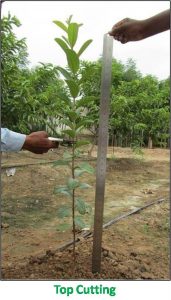
2. New shoots below the cut start emerging; these are allowed to grow if they are coming in between 1.5 ft to 2 ft from ground level. Sprouts coming below this level are removed.
3. To maintain proper balance of VNR Bihi plant, we select 5 healthy growing branches. Out of 5 branches,
A) 4 branches are allowed in 4 directions and
B) 1 branch is tied with bamboo stake for vertical growth of plant
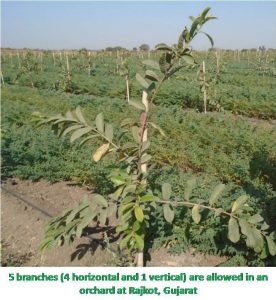
4. When horizontal branches achieves or reaches length of 2 ft from their point of emergence, they are cut. These branches are called as secondary branches/shoots.
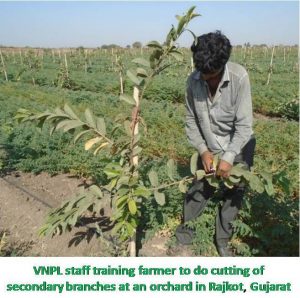
5. Branches grown below 1.5 ft from ground level are removed. These branches, if allowed to be grown furhter, will touch the ground and help insects/pests to climb the plant. Further, these branches interfere in undertaking intercultural operations at the base of the plant.
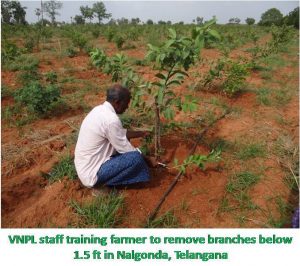
6. Fifth (5th) secondary branch, which was tied with bamboo stake to grow vertical, is subject to a cut–when it achieves/reaches height of 5 ft from ground level.
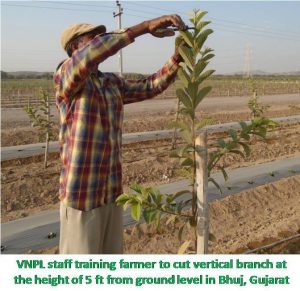
7. Tertiary branches (branches coming out from secondary branches) are also cut, when they attain 2 ft length from their point of origin/emergence in secondary branch.
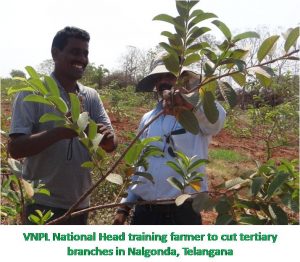
8. Tertiary sub-branches coming out of tertiary branches if growing inwardly or interfering with other branches are cut/removed. These braches-if not removed, will not allow sunlight to reach the centre of VNR Bihi plant and interfere with growth of plant.
Cut every branch from its origin, when it achieves/reaches 2 feet length.
DOs and DONTs:
DOs > Do the cutting of branches as directed by VNPL.
DONTs > Do not do excessive cutting of plant. If excess cutting is done, plant becomes bushy. Bushy plants bear lesser number of fruits.
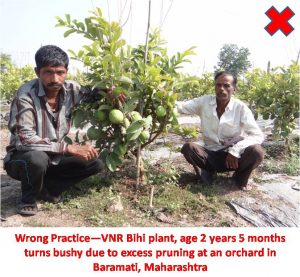
DOs >Cut branches if length is more than 2 feet OR tie these branches with stake by jute thread (sutli)
DONTs > Do not tie all branches together with stake to protect branches from wind.
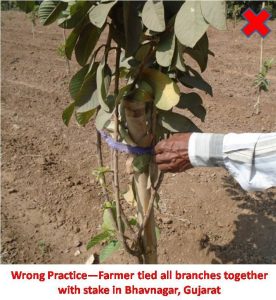
Frequently Asked Questions (FAQs):
Q – What if 5 branches are not coming after top cutting?
Answer: Sometimes only 2 or 3 branches emerge after top cutting, in this case farmer can allow these branches to attain 2 ft length and again, do tip cutting. After this cutting when sprouts come in these 2 branches, we can allow these sprouts to grow in desired directions as secondary branches.
Q – Can we tie all branches together with stake to prevent branches from breaking in high/heavy wind blowing areas?
Answer: No, this is a wrong practice. Farmer can prune the branches if they are prone to breakage in high/heavy winds.
Q – What if plant becomes bushy due to excessive cutting?
Answer: The plant when becomes bushy, it is confined to canopy that is less to its expected spread. This reduces the production area of the plant. Moreover, sunlight interception will be less in bushy plants which may result in development of insect/pest colonies.
Few other Customized training methods undertaken by farmers:
1. Training of plants by tying branches with overhead wire supported by bamboo structure: In this method, individual branches are tied with overhead wire supported by bamboo structure. This method is recommended for low acreage as this is tedious and labour intensive job.
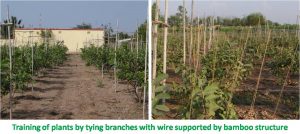
2. Plant is supported by bamboo sticks: In this method, plant is supported by surrounding bamboo sticks. These sticks are moved in desired space as the plant grows. This method is also recommended for low acreage of VNR-BIHI and involves high cost and labour.


